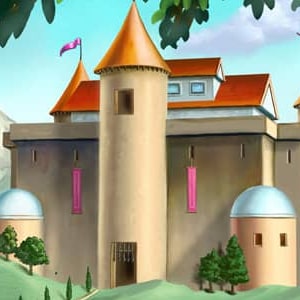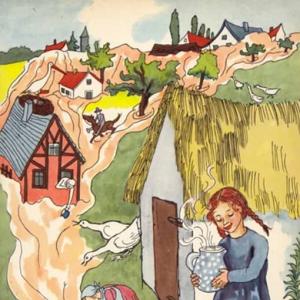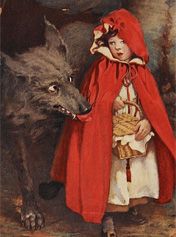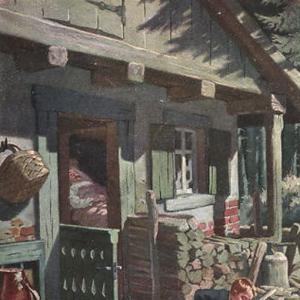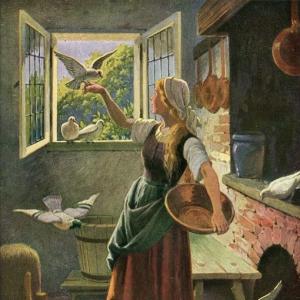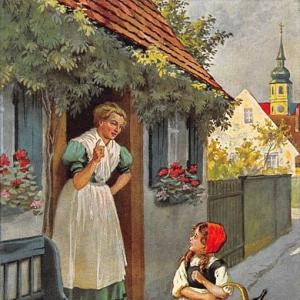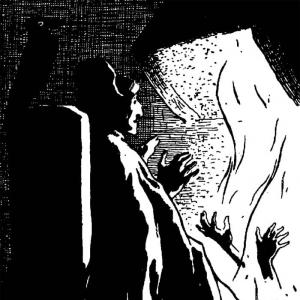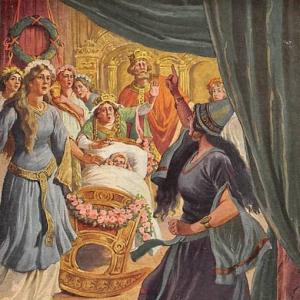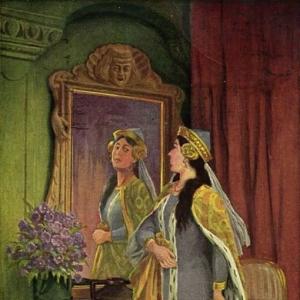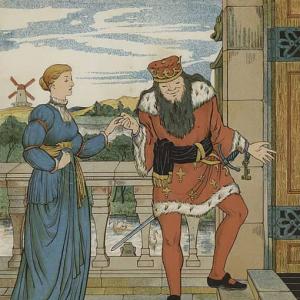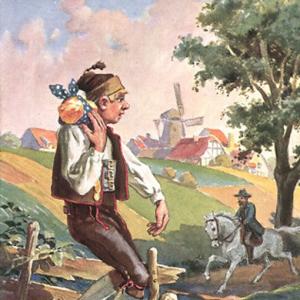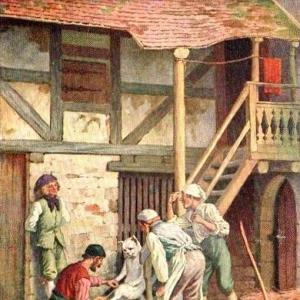Reading time: 3 min
There were once upon a time two sisters, one of whom had no children and was rich, and the other had five and was a widow, and so poor that she no longer had food enough to satisfy herself and her children. In her need, therefore, she went to her sister, and said, „My children and I are suffering the greatest hunger; thou art rich, give me a mouthful of bread.“ The very rich sister was as hard as a stone, and said, „I myself have nothing in the house,“ and drove away the poor creature with harsh words. After some time the husband of the rich sister came home, and was just going to cut himself a piece of bread, but when he made the first cut into the loaf, out flowed red blood. When the woman saw that she was terrified and told him what had occurred. He hurried away to help the widow and her children, but when he entered her room, he found her praying. She had her two youngest children in her arms, and the three eldest were lying dead. He offered her food, but she answered, „For earthly food have we no longer any desire. God has already satisfied the hunger of three of us, and he will hearken to our supplications likewise.“ Scarcely had she uttered these words than the two little ones drew their last breath, whereupon her heart broke, and she sank down dead.
 Learn languages. Double-tap on a word.Learn languages in context with Childstories.org and Deepl.com.
Learn languages. Double-tap on a word.Learn languages in context with Childstories.org and Deepl.com.Backgrounds
Interpretations
Adaptions
Summary
Linguistics
„God’s Food“ is a lesser-known fairy tale from the Brothers Grimm’s collection, which has been translated and adapted into various languages over the years. The Brothers Grimm, Jacob and Wilhelm, were German scholars, linguists, and cultural researchers who are best known for their collection of folktales and legends. They published their first volume of „Children’s and Household Tales“ in 1812, containing 86 stories. By the time the seventh edition was published in 1857, the collection had grown to include over 200 tales.
The Brothers Grimm aimed to preserve and document the oral tradition of German folklore, which they believed was an essential part of their national cultural heritage. Their work has had a significant impact on the study of folklore and the development of the fairy tale genre, inspiring countless writers, artists, and filmmakers worldwide.
„God’s Food“ reflects the darker side of the Grimm’s fairy tales, featuring themes such as hardship, suffering, and death. The story is set in an unspecified time and place, which is typical for many of their tales. The characters, like those in many other Grimm’s stories, can be seen as archetypes, representing various aspects of human nature and society. The rich sister embodies selfishness and greed, while the poor widow and her children represent humility, faith, and the harsh reality faced by many people living in poverty.
Like many other tales from the Brothers Grimm, „God’s Food“ has moral and ethical lessons embedded within its narrative, aiming to teach readers about the importance of compassion, empathy, and the consequences of our actions.
„God’s Food“ is a cautionary tale that can be interpreted in several ways. Here are three main interpretations:
The consequences of selfishness and lack of compassion: The tale highlights the dangers of being self-centered and lacking empathy for others in need. The rich sister’s unwillingness to help her struggling family members leads to their tragic deaths. This story serves as a reminder that we should always be compassionate and charitable towards those who are less fortunate, as our actions can have far-reaching consequences.
The power of faith and the role of divine intervention: Despite their dire circumstances, the poor widow and her children maintain their faith in God, believing that He will provide for their needs. Their deaths can be seen as a form of divine intervention, as they are finally freed from their suffering and reunited with their deceased loved ones. This interpretation emphasizes the importance of maintaining one’s faith in times of adversity, and the belief that God will provide solace and relief in the end.
The concept of justice and retribution: The story also highlights the idea of justice and retribution for one’s actions. The rich sister’s refusal to help her family is punished when her husband discovers the bread filled with blood, a symbolic representation of her cold-heartedness and the suffering she has caused. In contrast, the poor widow and her children, who remained faithful and righteous in their suffering, are ultimately relieved of their pain and united in death. This interpretation emphasizes the idea that actions have consequences, and that justice will eventually be served.
Overall, „God’s Food“ is a powerful tale that teaches important lessons about compassion, empathy, faith, and the consequences of our actions.
The fairy tale „God’s Food“ (also known as „God’s Gifts“ or „The Tablecloth, the Donkey, and the Stick“) has been adapted in various forms over the years. Here are some notable adaptations:
„The Magic Tablecloth“: This is an animated short film produced by Soyuzmultfilm in 1963. It is a faithful adaptation of the Grimm Brothers‘ tale, with the story told through beautiful animation and music.
„The Magic Table“: This is a children’s book written by Donna Jo Napoli and illustrated by Gabhor Utomo. It is a modern retelling of the Grimm Brothers‘ tale, set in a poor village in Indonesia. The story has been adapted to fit the culture and setting of Indonesia, but the themes of greed and gratitude remain the same.
„The Donkey and the Stick“: This is a play by William Butler Yeats, first performed in 1920. It is based on the Grimm Brothers‘ tale, but Yeats has adapted the story to fit his own poetic style. The play explores themes of power and corruption, and the consequences of abusing power.
„The Wishing Table“: This is an English-language version of the story, published in the 19th century. It is a retelling of the Grimm Brothers‘ tale, but with some changes to the plot and characters. For example, the tablecloth is replaced with a wishing table that can produce any food or drink, and the donkey is replaced with a magic purse that always contains gold coins.
„God’s Gifts“: This is a picture book adaptation of the Grimm Brothers‘ tale, written by Demi. The book features beautiful illustrations and simplifies the story for younger readers. The book emphasizes the importance of gratitude and humility, and the dangers of greed and arrogance.
Overall, the story of „God’s Food“ has inspired many adaptations over the years, each putting their own spin on the classic tale while preserving its timeless themes and lessons.
„God’s Food“ is a grim fairy tale by Brothers Grimm about two sisters – one wealthy and childless, while the other a poor widow with five children. The poor widow and her children are starving, so she approaches her rich sister for help. However, her sister is cold-hearted and refuses to offer assistance, claiming that she has nothing to spare.
Later, when the rich sister’s husband returns home and tries to cut a loaf of bread, blood flows out of it. Horrified, the wife tells him about the widow’s visit, and he rushes to help the needy family. Upon entering their home, he finds the widow praying, with three of her children already dead and the remaining two clinging to life. He offers them food, but the widow states that they no longer need earthly sustenance, as God has already answered their prayers and satisfied the hunger of three of her children.
As she speaks, the remaining two children pass away, and the widow, unable to bear the pain, dies of a broken heart. The tragic tale demonstrates the consequences of selfishness and the importance of compassion and generosity towards those in need.
The fairy tale „God’s Food“ by the Brothers Grimm offers a rich ground for linguistic and thematic analysis. Here’s an exploration of its language and underlying elements:
Syntax and Structure: The narrative employs straightforward syntax alongside complex interwoven clauses, characteristic of classic fairy tales which aim for a concise yet lyrical storytelling style. The use of archaic second-person singular pronouns and verbs (e. g. , „thou art“) reflects the historical linguistic context and adds to the story’s timeless quality.
Lexical Choices: Words like „creature,“ „supplications,“ and „hearken“ evoke a biblical or moralistic resonance, common in Grimm tales, which often carry underlying Christian or moral themes. The repeated use of words related to hunger and sustenance („hunger,“ „bread,“ „food“) underscores the central conflict and heightens the emotional tension.
Imagery and Symbolism: Blood flowing from the loaf is a powerful, visceral image symbolizing guilt and the consequence of the rich sister’s heartlessness. The act of praying by the widow, despite her dire circumstances, intensifies the sense of piety and martyrdom, evoking sympathy from the reader.
Thematic Elements
Contrast and Irony: The stark contrast between wealth and poverty is central to the narrative. The rich sister’s denial and subsequent supernatural punishment highlight the moral lesson against greed and indifference. Irony is present in the rich sister’s statement of having „nothing in the house,“ as the bleeding loaf later reveals an abundance tainted by guilt.
Sacrifice and Martyrdom: The widow’s willingness to forsake earthly sustenance reflects themes of sacrifice and religious devotion. Her eventual death symbolizes ultimate relief through divine intervention, albeit tragically. The widow’s resignation to divine will suggests a narrative endorsement of faith and piety over material wealth.
Divine Justice: The story uses elements of supernatural justice (the bleeding loaf) as a moral corrective, an embodiment of the Grimm tradition where wrongs are often supernaturally avenged. This divine intervention contrasts human apathy with celestial morality, imparting a strong ethical directive to the audience.
Cultural and Historical Context
Moral Didacticism: The tale reflects the 19th-century European cultural context in which it was written, emphasizing moral lessons through narrative fiction—common in tales collected by the Brothers Grimm.
Societal Reflection: Themes of hunger and poverty may mirror historical societal conditions, particularly class disparities, invoking empathy and moral reflection in readers.
In summary, „God’s Food“ employs linguistic simplicity intertwined with vivid imagery and rich themes to convey moral truths. Its focus on poverty, morality, and divine justice presents a timeless tale that resonates with cultural and ethical reflections.
Information for scientific analysis
Fairy tale statistics | Value |
|---|---|
| Number | KHM 205 |
| Aarne-Thompson-Uther-Index | ATU Typ 751G |
| Translations | DE, EN |
| Readability Index by Björnsson | 37.9 |
| Flesch-Reading-Ease Index | 74.2 |
| Flesch–Kincaid Grade-Level | 8.9 |
| Gunning Fog Index | 11.2 |
| Coleman–Liau Index | 8.3 |
| SMOG Index | 8.7 |
| Automated Readability Index | 10 |
| Character Count | 1.283 |
| Letter Count | 996 |
| Sentence Count | 10 |
| Word Count | 243 |
| Average Words per Sentence | 24,30 |
| Words with more than 6 letters | 33 |
| Percentage of long words | 13.6% |
| Number of Syllables | 310 |
| Average Syllables per Word | 1,28 |
| Words with three Syllables | 9 |
| Percentage Words with three Syllables | 3.7% |

 Facebook
Facebook  Whatsapp
Whatsapp  Messenger
Messenger  Telegram
Telegram Reddit
Reddit